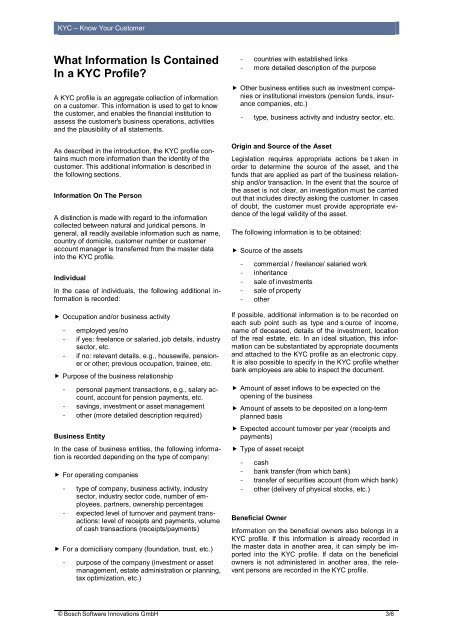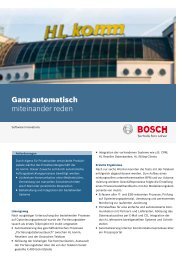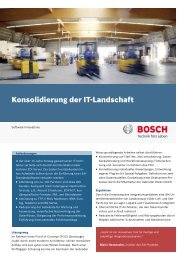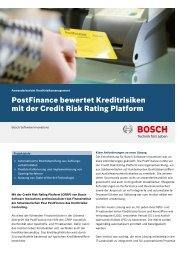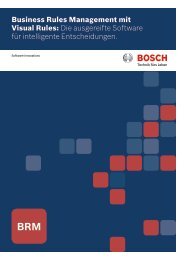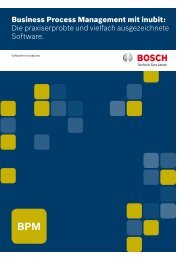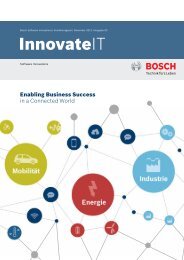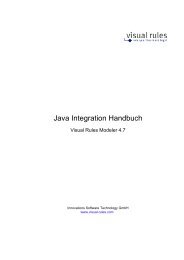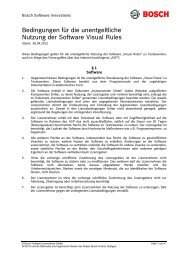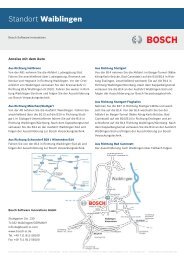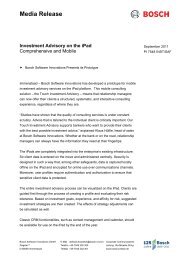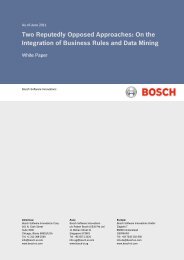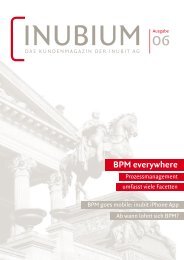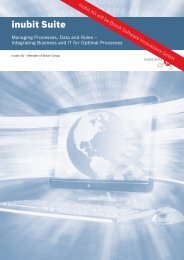KYC-Know Your Customer - Bosch Software Innovations
KYC-Know Your Customer - Bosch Software Innovations
KYC-Know Your Customer - Bosch Software Innovations
You also want an ePaper? Increase the reach of your titles
YUMPU automatically turns print PDFs into web optimized ePapers that Google loves.
<strong>KYC</strong> – <strong>Know</strong> <strong>Your</strong> <strong>Customer</strong><br />
What Information Is Contained<br />
In a <strong>KYC</strong> Profile?<br />
A <strong>KYC</strong> profile is an aggregate collection of information<br />
on a customer. This information is used to get to know<br />
the customer, and enables the financial institution to<br />
assess the customer's business operations, activities<br />
and the plausibility of all statements.<br />
As described in the introduction, the <strong>KYC</strong> profile contains<br />
much more information than the identity of the<br />
customer. This additional information is described in<br />
the following sections.<br />
Information On The Person<br />
A distinction is made with regard to the information<br />
collected between natural and juridical persons. In<br />
general, all readily available information such as name,<br />
country of domicile, customer number or customer<br />
account manager is transferred from the master data<br />
into the <strong>KYC</strong> profile.<br />
Individual<br />
In the case of individuals, the following additional information<br />
is recorded:<br />
� Occupation and/or business activity<br />
employed yes/no<br />
if yes: freelance or salaried, job details, industry<br />
sector, etc.<br />
if no: relevant details, e.g., housewife, pensioner<br />
or other; previous occupation, trainee, etc.<br />
� Purpose of the business relationship<br />
personal payment transactions, e.g., salary account,<br />
account for pension payments, etc.<br />
savings, investment or asset management<br />
other (more detailed description required)<br />
Business Entity<br />
In the case of business entities, the following information<br />
is recorded depending on the type of company:<br />
� For operating companies<br />
type of company, business activity, industry<br />
sector, industry sector code, number of employees,<br />
partners, ownership percentages<br />
expected level of turnover and payment transactions:<br />
level of receipts and payments, volume<br />
of cash transactions (receipts/payments)<br />
� For a domiciliary company (foundation, trust, etc.)<br />
purpose of the company (investment or asset<br />
management, estate administration or planning,<br />
tax optimization, etc.)<br />
countries with established links<br />
more detailed description of the purpose<br />
� Other business entities such as investment companies<br />
or institutional investors (pension funds, insurance<br />
companies, etc.)<br />
type, business activity and industry sector, etc.<br />
Origin and Source of the Asset<br />
Legislation requires appropriate actions be t aken in<br />
order to determine the source of the asset, and t he<br />
funds that are applied as part of the business relationship<br />
and/or transaction. In the event that the source of<br />
the asset is not clear, an investigation must be carried<br />
out that includes directly asking the customer. In cases<br />
of doubt, the customer must provide appropriate evidence<br />
of the legal validity of the asset.<br />
The following information is to be obtained:<br />
� Source of the assets<br />
commercial / freelance/ salaried work<br />
inheritance<br />
sale of investments<br />
sale of property<br />
other<br />
If possible, additional information is to be recorded on<br />
each sub point such as type and s ource of income,<br />
name of deceased, details of the investment, location<br />
of the real estate, etc. In an i deal situation, this information<br />
can be substantiated by appropriate documents<br />
and attached to the <strong>KYC</strong> profile as an electronic copy.<br />
It is also possible to specify in the <strong>KYC</strong> profile whether<br />
bank employees are able to inspect the document.<br />
� Amount of asset inflows to be expected on the<br />
opening of the business<br />
� Amount of assets to be deposited on a long-term<br />
planned basis<br />
� Expected account turnover per year (receipts and<br />
payments)<br />
� Type of asset receipt<br />
cash<br />
bank transfer (from which bank)<br />
transfer of securities account (from which bank)<br />
other (delivery of physical stocks, etc.)<br />
Beneficial Owner<br />
Information on the beneficial owners also belongs in a<br />
<strong>KYC</strong> profile. If this information is already recorded in<br />
the master data in another area, it can simply be imported<br />
into the <strong>KYC</strong> profile. If data on t he beneficial<br />
owners is not administered in another area, the relevant<br />
persons are recorded in the <strong>KYC</strong> profile.<br />
© <strong>Bosch</strong> <strong>Software</strong> <strong>Innovations</strong> GmbH 3/6


